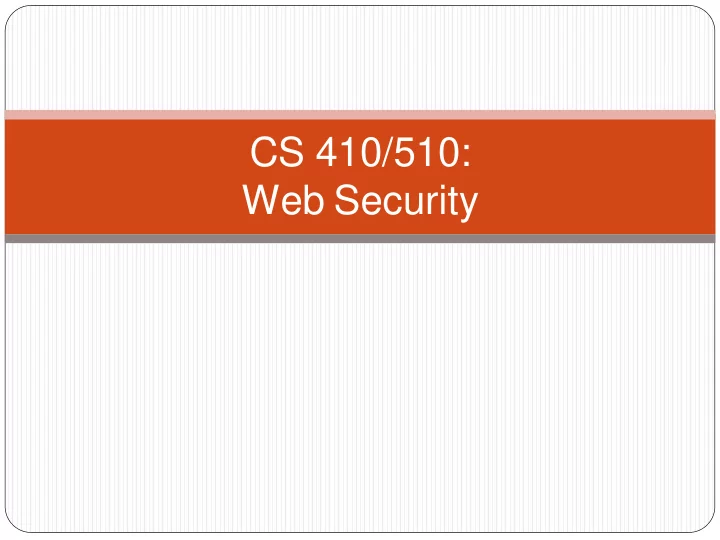

CS 410/510: Web Security
Motivation Security issues are having a real impact 2016 election Stuxnet Snowden F-35 fighter Bangladesh heist
Problem
Example: Russian 2016 election hacking Influence election via fake news and exposing secrets Destroy confidence in the US election system Slow down voting systems used in strategic local election offices Compromise machines used to count votes and register voters https://www.bloomberg.com/news/articles/2017-06-13/russian- breach-of-39-states-threatens-future-u-s-elections
Future elections What should we focus on for 2018? Election systems only considered critical infrastructure recently Gen. John Allen https://www.lawfareblog.com/lawfare-podcast- brookings-panel-cybersecurity-us-elections “As a guy who has spent a lot of time overseas dealing with threats to America, I now recognize at the speed of light, the very heartland of America is under threat today. The enemy has moved beyond my reach. The first line of defense of American democracy and the last line of defense are in our states and counties.”
Why web security? Most new apps offered via web Web as a “carrier” protocol for Internet apps Exploitation via the web now a common vector SQL injection Cross-site requests Session hijacking Click-jacking
Why web security? https://www.owasp.org/index.php/OWASP_Portland_2017_Training_Day https://www.eventbrite.com/e/portland-owasp-training-day-2017-tickets- 37297273148 https://bsidespdx.org/
Example: Equifax identity dump A problem you can help fix (after this class)
This course A quick primer on the web and how it works A look at common classes of web vulnerabilities Hands-on practice exploiting web vulnerabilities Exercises to demonstrate the overall vulnerability class Help train an adversarial mindset Prevention techniques Will hopefully be useful at some point in your career
Format Lectures followed by labs and homework
Based all on CTFs “Capture -the- Flag” Sets of challenges used in security competitions Understand and apply specific security concepts to find a hidden flag Used to train a variety of skills (reverse-engineering, exploitation, cryptography etc.) Focus on skill development Puts valuable content in a fun format Many CTFs focused on web security due to its importance Why build a course on CTFs? Extracurricular CTF not working CTF for credit!
In-class labs and lab notebook Short lectures reviewing an issue in web security In-class labs to demonstrate and exploit Can optionally be done in pairs Peer learning Ensure progression Write-ups for each level to be kept in a single lab notebook document turned in at the end of course Grading rubric Number of levels solved Description of vulnerability Description of technique, URL, or script used to exploit vulnerability Description of prevention or other remediation to mitigate threat Will require some short Ruby programs
Homework and programs To be done individually Homework CTF http://cs410.oregonctf.org Levels opened up (and closed) as we go along Programming assignments Python programs to programmatically attack web vulnerabilities Assumes knowledge of Python or willingness to learn it on your own Suggested book: Lubanovic , “Introducing Python”
Final project Can optionally be done in pairs Chosen from selected PentesterLab exercises Turned in as a screencast walkthrough posted on course channel on MediaSpace (https://media.pdx.edu) Grading rubric Exercise difficulty Availability of prior walkthroughs Clarity and completeness of walkthrough (including setup) Analysis of vulnerability and description of prevention/remediation Final exam slot Walkthrough of another group’s final project
Attendance and participation Attendance graded Treat classes as practice (e.g. like in sports, music) Special days OWASP workshop https://www.eventbrite.com/e/portland-owasp-training-day-2017- tickets-37297273148 You may make-up absences by attending one Turn in your badge for credit Bsides PDX Class exchange for Wednesday, Nov 22 nd Attend at least one session on Friday Oct. 20 or Saturday Oct. 21 to replace this class Registration is free at https://bsidespdx.org Turn in your badge for credit
Schedule and Grading See web site
Course logistics Course site (https://thefengs.com/wuchang/courses/cs410) Schedule Grading Content links Homework site (http://cs410.oregonctf.org) Program submission via D2L (https://d2l.pdx.edu) Final project submission via Media Space (https://media.pdx.edu) Course discussion on #cs410_510_websecurity on Slack (https://pdx-cs.slack.com) Instructor contact @wuchang on pdx-cs Slack In-class questions and feedback (anonymous) https://sayat.me/wu4f
Ethics You will learn techniques and tools for compromising web systems Do *NOT* use them against any site outside of the course web sites unless given permission CTFs and private instances help you learn and practice security concepts (without breaking the law) CFAA
Extra
Preview Jeff Williams, Dave Wichers (2013) Vulnerabilities ranked based on business risk (likelihood + impact)
Recommend
More recommend